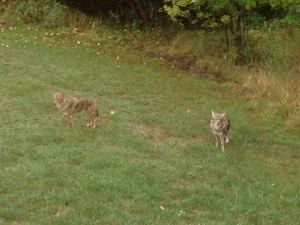Encroaching coyotes
insidenova.com
A pair of coyotes hangs out in a backyard near Dumfries.
Yes, Northern Virginia, we have coyotes. Get used to it, they’re here to stay.
“Coyotes are well established here and the population is growing,” state
wildlife biologist Kevin Rose said. “They are good at adapting to the
environment we create.”
Though typically elusive, over the past year or so coyotes have become
an almost regular sight, and sound, in Northern Virginia, particularly in
southeastern Prince William County.
Several people have snapped photos of them strolling across crowded
residential neighborhoods, or hanging out in backyards.
There have also been rumors of missing cats and small dogs, thought
to have become meals for the feared canines.
“Last week they took two little dogs in my neighborhood in Triangle,
near Quantico. We saw a huge one carrying a little animal about 20
feet away from usin the middle of the street!” Carla Aikens said on
InsideNoVa.com’s Facebook page.
State and local officials say we are seeing many more of them
, and they have become comfortable enough – or brazen enough –
to claim our territory as theirs.
Despite some rumors to the contrary, coyotes weren’t introduced
to the east to control deer populations. They slowly migrated here,
and were first observed in western Virginia in the 1950s.
“Coyotes were not moved here by the [Marine Corps] or anyone else,”
Rose said.
As the nation’s populations of other top predators, like wolves and
mountain lions, declined, the cunning coyote moved in to fill the void.
“Wolves tend to limit coyote abundance because they see another
large ‘dog’ as a threat,” Rose said.
Coyotes in Northern Virginia followed a specific route to get here
from the north, and they had some encounters with wolves along
the way, according to a 2011 study in the Journal of Mammalogy.
Researchers with the Smithsonian Conservation Biology Institute
studied the scat (or feces) of the area’s coyotes and found that
they bred with the wolves of the Great Lakes.
Thanks to their wolf DNA, Northern Virginia’s coyotes are larger
than their western counterparts, said Paul Petersen, a wildlife
biologist and chief of resource management at Prince William
Forest Park.
And while wolf populations in the country continue to decline
, the coyote population is booming.
Coyotes are omnivores. They east small mammals like mice
and groundhogs, and native fruits like blackberries and
blueberries. But we may be seeing more of them because
– like black bears – they also enjoy trash, pet food, bird seed
and meat in compost piles.
“Opportunities for those kinds of meals are common around
human populations,” Rose said.
While it doesn’t happen often, coyotes are opportunists and
will eat cats and small dogs.
“They are not vicious evil animals, but will make an easy meal
of pets if given the chance,” Rose said.
Prince William police advise people who live in neighborhoods
where coyotes have been spotted to bring their pets inside at night.
Even more rare are coyote attacks on people, though the animals
are very territorial and will defend their dens.
“Coyotes defend their territories and especially their den areas
from all other animals,” Rose said. “Therefore, if they set up a
den, they would attack animals larger than they see as prey in
order to defend their family and territory. This accounts for most
attacks on larger dogs and adults.”
The state has deemed coyotes a “nuisance animal,” and there
are no bag limits or hunting seasons for the canines.
Coyotes can be “killed at will,” but not in areas where shooting
is prohibited, and not on Sundays, Rose said.
“Virginia Department of Game and Inland Fisheries regulations,
such as the designation of coyotes as a nuisance animal, do not
supersede local ordinances regulating discharge of firearms,”
Rose said.
Shooting is prohibited in most of Prince William County, said
police spokesman Jonathan Perok.
Some counties in the state will pay a bounty for dead coyotes
. But no jurisdictions in Northern Virginia do not, and there is
no statewide bounty.
Rose says hunting coyotes out of existence isn’t going to work
anyway. “Living in an area that has coyotes is a lot like living
in areas with bears. Do not leave attractants out that encourage
the animal to come onto your property. Without the promise of
food, they generally don’t have an interest in hanging around,”
he said.
And while you might successfully shoo them from your backyard,
expect it to be an ongoing battle.
“Just like with bears, humans are going to have to learn to live
with our wildlife, not expect that to live separate from it,” Rose said.











No comments:
Post a Comment